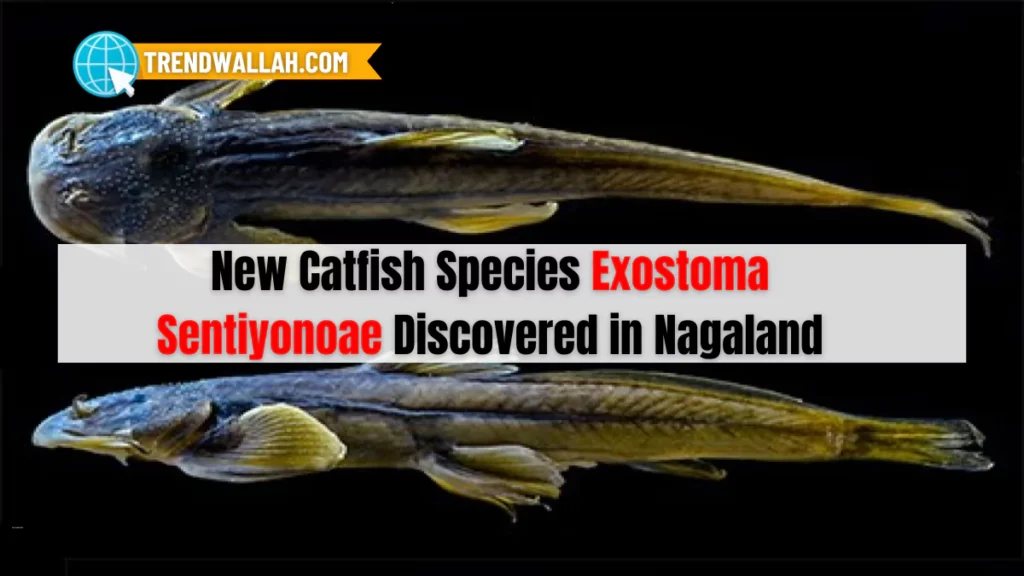
A new species of catfish, Exostoma sentiyonoae, has been discovered in the Dzuleke River, a tributary of the Barak River, in Nagaland, India. This important discovery highlights the rich aquatic biodiversity of the region and marks the fourth species of the Exostoma genus described from the Barak drainage.
Key Details of the Exostoma Sentiyonoae Discovery
The discovery of Exostoma sentiyonoae was made by researchers Bungdon Shangningam from the Zoological Survey of India and Limatemjen from Kohima Science College. The findings were published in the scientific journal Zootaxa. The newly identified catfish measures 75.8 mm and is categorized as holotype ZSI FF 9871.
Unique Characteristics of Exostoma Sentiyonoae
This new species stands out from other species in its genus due to its distinct physical traits, such as:
- Adipose fin connected to the upper caudal-fin rays.
- Tubercles present on the dorsal-fin spine.
- A slender head and a large gap between the dorsal and adipose fins.
- Small eyes and a total of 41 vertebrae.
The researchers found notable differences between Exostoma sentiyonoae and other species like E. berdmorei and E. gaoligongense, such as its shorter dorsal-fin base and smaller eyes.
Comparison with Related Species
| Species | Key Differences from Exostoma sentiyonoae |
| E. berdmorei | Shorter dorsal-fin base, longer distance between dorsal and adipose fins, and smaller eyes. |
| E. gaoligongense | Shorter distance between pectoral and pelvic fins, and smaller eyes. |
| E. effreni | Wider head and deeper caudal peduncle compared to Exostoma sentiyonoae. |
| E. peregrinator | Longer dorsal-adipose fin distance and a shorter anal-fin base. |
Impact of the Exostoma Sentiyonoae Discovery
National Impact
This discovery highlights Nagaland’s rich biodiversity and the need for further research in remote areas like the Dzuleke River. The identification of Exostoma sentiyonoae increases knowledge of the region’s fish species and could lead to the discovery of more new species.
Global Impact
The discovery of a new species like Exostoma sentiyonoae showcases the potential for scientific exploration in under-researched areas. This will encourage more international interest in conservation efforts and ecological research in biodiversity hotspots like the Eastern Himalayas.
Motivation Behind the Research
The motivation behind this research was to explore the rich aquatic ecosystems of Nagaland and understand the biodiversity in less studied rivers. The discovery is part of a broader effort to document and protect unique fish species in this region. Future research will focus on conducting further surveys, including genetic studies and conservation efforts.
Exostoma Sentiyonoae –Key Points
- A new catfish species, Exostoma sentiyonoae, was discovered in Nagaland’s Dzuleke River.
- It has distinct features like an adipose fin, tubercles on the dorsal fin spine, and 41 vertebrae.
- This is the fourth species of the Exostoma genus identified from the Barak River system.
- More research is required to explore the biodiversity in the region.
Read Official Coverage of New Species.
Also Read Latest Current Affairs 2024
Exostoma sentiyonoae is a newly discovered species of catfish found in the Dzuleke River, Nagaland.
It was discovered in the Dzuleke River, part of the Barak River system in Nagaland, India.
It has unique features like a connected adipose fin, tubercles on the dorsal fin spine, and smaller eyes compared to other species.
This discovery highlights the rich biodiversity of Nagaland’s rivers and the need for further research in the region.
Researchers plan to conduct more surveys in Nagaland’s rivers, focusing on genetic studies and conservation efforts.
